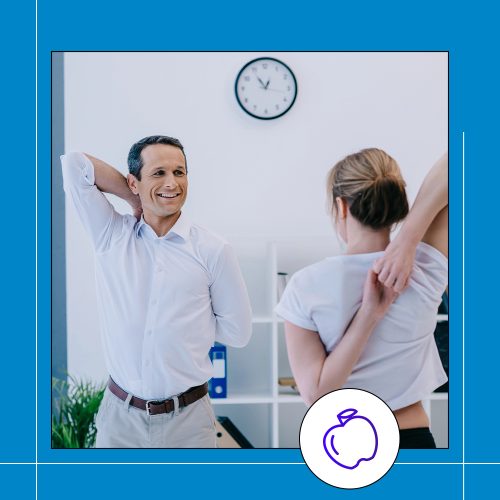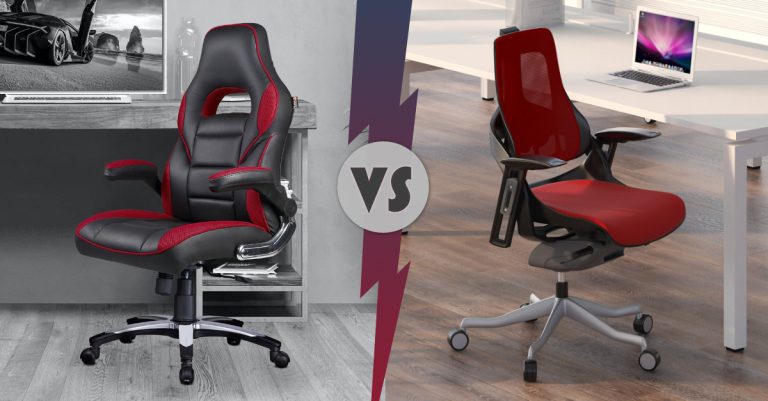Why is Movement so Important During Your Workday?
According to the Australian Bureau of Statistics (ABS), nearly half of employed adults aged 18-64 (46.9%) described their workday as mostly spent sitting, with walking and standing the next most common activities (20.4% and 18.9%). Effectively, people who perform office-based or screen-based roles spend nearly three-quarters of their time on sedentary activities.
Furthermore, a 2023 study found that only around half of Australian adults (55%) are active enough to maintain good health (defined as at least 150 minutes of moderate intensity physical activity a week achieved over five or more sessions).
This lack of physical activity heightens your risk of developing or worsening a range of health issues, including:
- Chronic health issues: Back problems, arthritis, asthma, diabetes, heart disease, COPD or cancer, affect around 49.9% of Australian adults (12.6 million people).
- Obesity: Studies show significant associations between a highly sedentary lifestyle and physical inactivity, and a high prevalence of obesity. Data released in 2023 shows that 65.8% of adult Australians are overweight or obese and at risk of developing the chronic health conditions above.
- Poor mental health: Studies (like this) have shown that people who engaged in a high level of physical activity were 17% less likely to develop depression and much less likely to suffer anxiety.
- Osteoporosis and fractures. Putting pressure on your skeletal system via weight-bearing exercise is vital to keep your bones strong.
The Benefits of Regular Movement Throughout the Day
The good news is that even small increases in the amount you move throughout the day can have significant benefits for your health.
- Improves Metabolic and Cardiovascular Health
- Short, frequent movement breaks (e.g., squats or walking every 30–45 minutes) better regulate post-meal blood glucose levels than a single longer exercise session, helping to reduce the risk of type 2 diabetes and metabolic disease.
- Reduces Musculoskeletal Discomfort and Pain
- Regular active micro-breaks help alleviate discomfort associated with prolonged static posture, such as neck and lower-back pain. A study of an 8-week program of physical activity breaks for desk workers found a significant reduction in self-reported musculoskeletal pain and stress, and post-lunch sleepiness.
- Boosts Energy, Reduces Fatigue, and Enhances Mood
- Movement increases oxygenated blood flow to the brain, sharpening concentration and cognitive processing—a benefit cited by occupational psychology reviews as improving productivity and efficiency.
- A review of micro-breaks (10 minutes or less) found that participants were around 60% more likely to feel energised and less fatigued during the day, particularly when breaks included brief active movement or stretching.
- Regular, small active breaks help you function at work by improving neurophysiological function, working memory, alertness, and perceived productivity.
- Incorporating short physical activity breaks during the workday has also been shown to significantly lower perceived stress and improve overall emotional wellbeing.
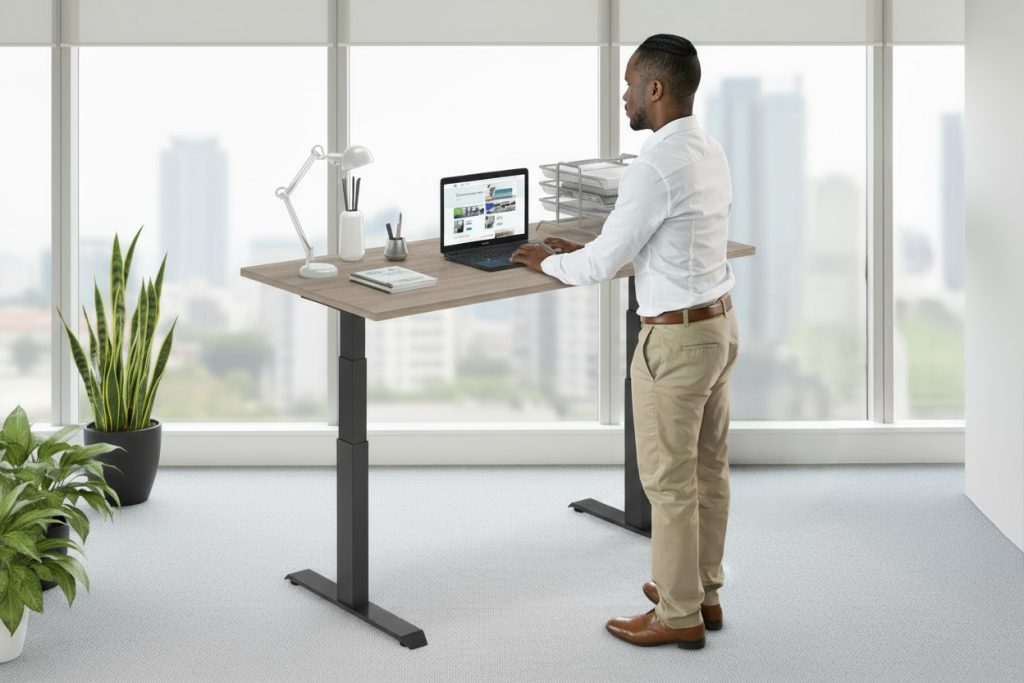
Ways to Get More Movement Without Leaving Your Desk
Get a standing desk
Standing desks and sit-stand desks have gained popularity in the last few years, and it’s easy to see why. Our post 10 Health Benefits of Standing Desks explains how this type of desk enables you to correct your posture, speed up your metabolism and burn some extra calories.
Standing for short periods of time is a simple way to incorporate more activity into your workday. In fact, multicomponent workplace studies (e.g. height-adjustable desks plus behavioural strategies) decreased sitting time by around 45 minutes per workday and are likely to improve cardiovascular markers in the long term.
The best sit-stand desks are electronically height-adjustable and allow you to program your ideal sitting and standing heights into the control. It’s important to build up your resistance slowly. Try standing for 20-minute intervals every hour or every 2-3 hours. We also recommend you wear comfortable shoes that support your feet.
BFX offers two models that suit different needs:
- Ascendo Single-Sided Electronic Sit-Stand Desk (with/without screen): the optional screen is a great option to maintain privacy and keep notes handy, while the scalloped to helps you keep cables neat and tidy.
- Ascendo Double Electronic Sit-Stand Workstation (with/without screen): a double workstation where each desk can be adjusted independently, allowing two people to work together in a way that looks after their health needs. A screen can be added between the desks for privacy.
Desk Risers (like BFX’s Rapid Desk Riser or Rapid Flux Electric Desk Riser) are a great way to transform fixed-height desks into sit-stand workstations for ergonomic versatility without having to invest in a new desk.
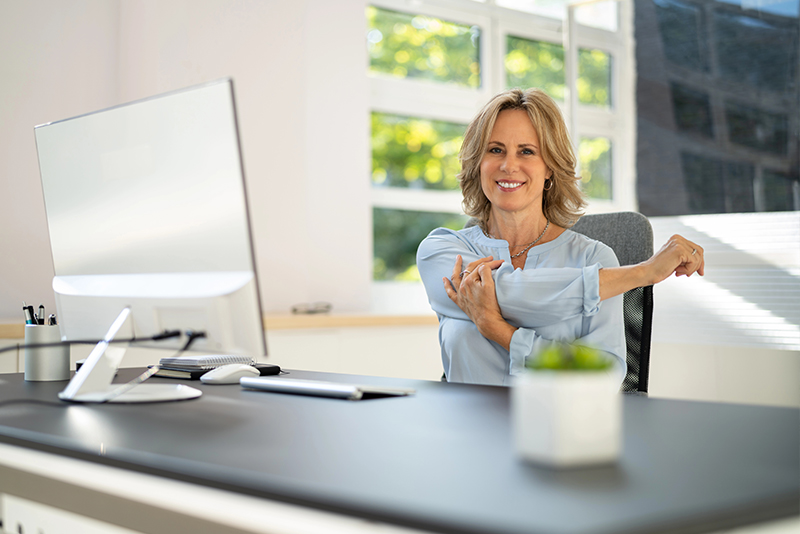
Get stretching
Stretching stimulates blood flow, loosens tight muscles, relieves stress and gives you an energy boost.
Set your alarm for a daily micro stretch program or 5-minute desk yoga routine that incorporates:
- Neck rotations: start slowly rolling your neck from left to right and back again.
- Sky to floor: stand up, raise your arms over your head and stretch up on your tip-toes, then bring your arms down, bend and touch your toes. Repeat.
- Shoulder stretch: whilst standing, stretch your right arm across your chest to the left and use your left arm to stretch it out, then swap.
- Shoulder rolls: bring your left shoulder up towards your ear and roll back in a clockwise motion, and then repeat the action anticlockwise. Switch to the right shoulder and repeat the same motion. You can also do both at the same time.
- Leg extensions: whilst sitting, extend one leg out and flex and point your foot, squeezing your thigh and calf muscles. Repeat on the other leg.
- Ankle rotations: lift one foot and rotate from the ankle, first clockwise and then anticlockwise. Repeat with the other foot.
- Lunges: while standing, place one foot about 50 centimetres in front of you and extend the other behind you while you bend into your front knee. Repeat on the other side.
Tip: Occupational Health Provider KINNECT has a free printable poster with office-appropriate stretches.
Bring the gym to the office with under-desk exercise equipment
Just because you’re at your desk doesn’t mean you can’t be exercising at the same time.
Foot cycle: used for years as a rehabilitation tool, portable foot cycles allow you to adjust the tension to make your mini-workout more challenging.
Walking pad: a slim-line version of a treadmill, walking pads are designed to be used with a sit-stand desk or desk riser. Walk during video calls, when watching videos or webinars, or when you need a burst of creativity.
Dynamic seating: you can train your muscles while you work by investing in seating that forces you to move and engage your core. A wobble, motion stool or an exercise ball encourages you to actively maintain your posture and move your hips and spine.
Technology Hacks to Improve Movement Opportunities at Work
Invest in a wearable fitness tracker or app
Trackers allow you to get an idea of just how much activity you’re getting (or not getting) throughout the workday and give you a nudge to stand or walk to get those numbers up.
Popular models like the Fitbit, Garmin, Oura Ring, or Samsung Galaxy are great all-around options that work with an app on your smartphone to track your progress. Most now also have a heart rate monitor, sleep tracker and pedometer.
If you don’t want to spend the money on expensive fitness trackers, there are plenty of free step counter apps that work with your phone’s GPS, or simply set reminders in our calendar or phone timer.
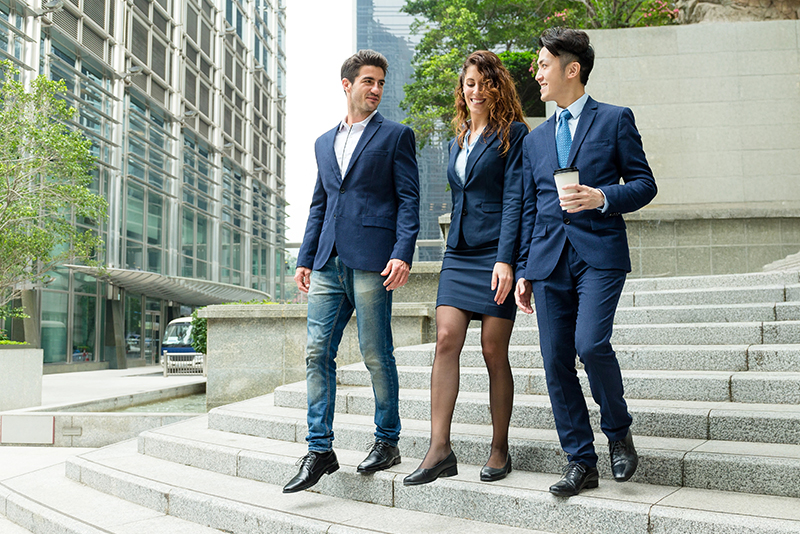
Ride or walk to work
If distance isn’t a problem, walking or riding to work, or even to your closest rail or bus station, counts towards your weekly recommended physical activity. It will save you money on fuel, and you’ll avoid the stress of being trapped in traffic.
Take a walking break
Introduce “timer-technique”: every 45 minutes, stand or walk for 5 minutes. Adopt the habit of leaving your desk to fill your water glass – water bottles are great for keeping us hydrated, but have made us lazy.
Make the most of lunch
This isn’t a new idea, but it works. Take walking lunches with food that you can eat on the go, such as sandwiches, wraps, sushi, smoothies, energy bars, muesli bars, or healthy muffins.
Invite colleagues along for your walk and make it a social event. Ensure you wear comfortable shoes or pack a spare pair of shoes to change into.
If you have time, hit the gym for a 20-minute high-intensity workout.
Create a movement culture at work
Get creative with your colleagues and find ways that you’ll all enjoy moving. Try:
- Setting up an active break zone with a few weights, resistance bands, space for stretching and a balance board. Add posters with exercise ideas for inspiration.
- Running competitions for the longest wall sit or plank, or the most squats or cubical/chair dips. Display a leaderboard to motivate everyone to continue
- Creating teams for charity competitions that get people moving,g. Steptember, The Push-Up Challenge.
- Encouraging walking meetings outside – it gets creative juices flowing and can produce better results than meeting rooms.
- Reminding people to use the stairs, rather than the lift.
Structured programs
While higher-intensity exercise outside of work is still required, formal education-based health programs and structured interventions that integrate active breaks and prompts have demonstrated modest gains in employee engagement, with employees reporting increased alertness and workflow continuity. There are many occupational health providers who can create a tailored program for your organisation.
Final words
Getting more physical activity in a workday doesn’t have to be arduous. By combining ideas, technology, and furniture, you and your colleagues can significantly enhance your mental and physical well-being and achieve the recommended amount of physical activity. Our consultants can help you create a more active workspace with furniture and a layout that supports your well-being – get in touch.
Key Takeaways:
- Aim for brief (2–5 minute) movement or walking breaks every 30–45 minutes rather than relying on a single longer session.
- Combine prompts, education, and environment (e.g. stand desks) to maximise uptake and adherence.
- Integrate active breaks with stretching, walking or light resistance to address both mental and physical wellness dimensions.


